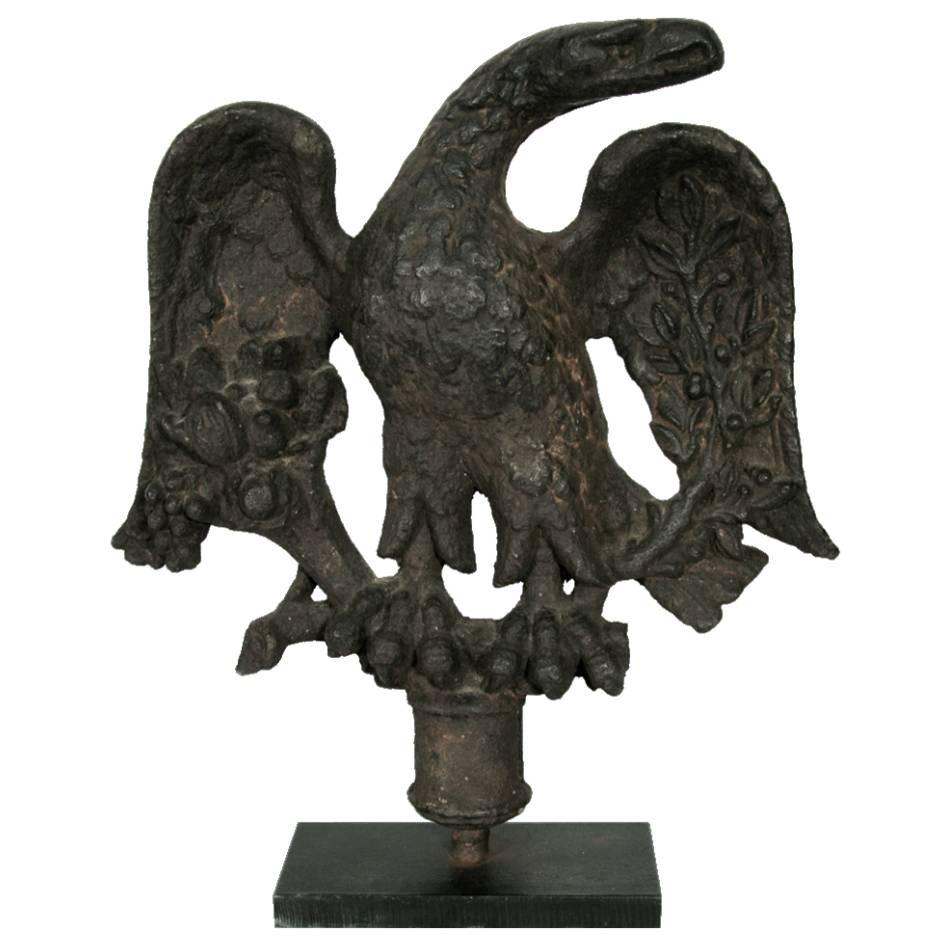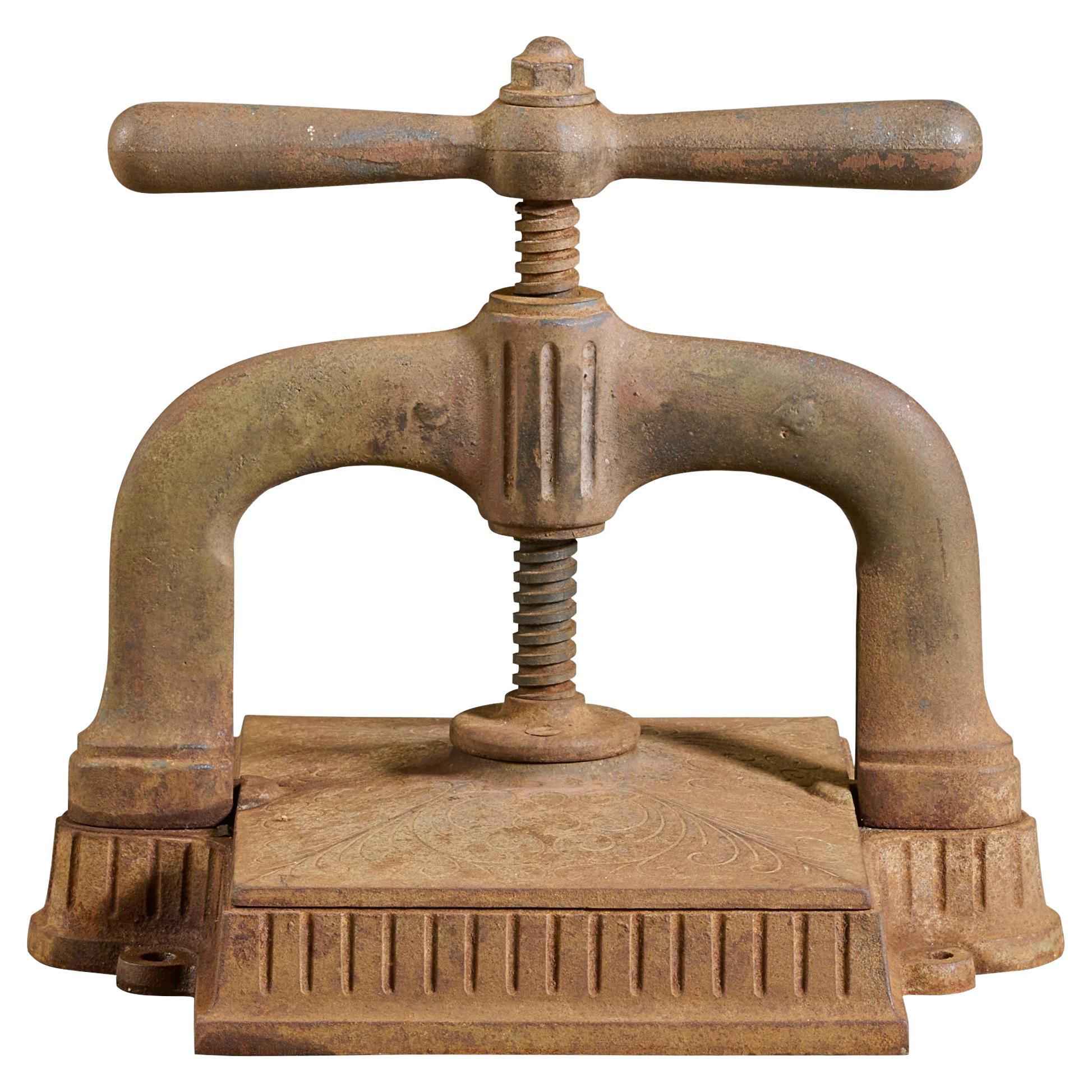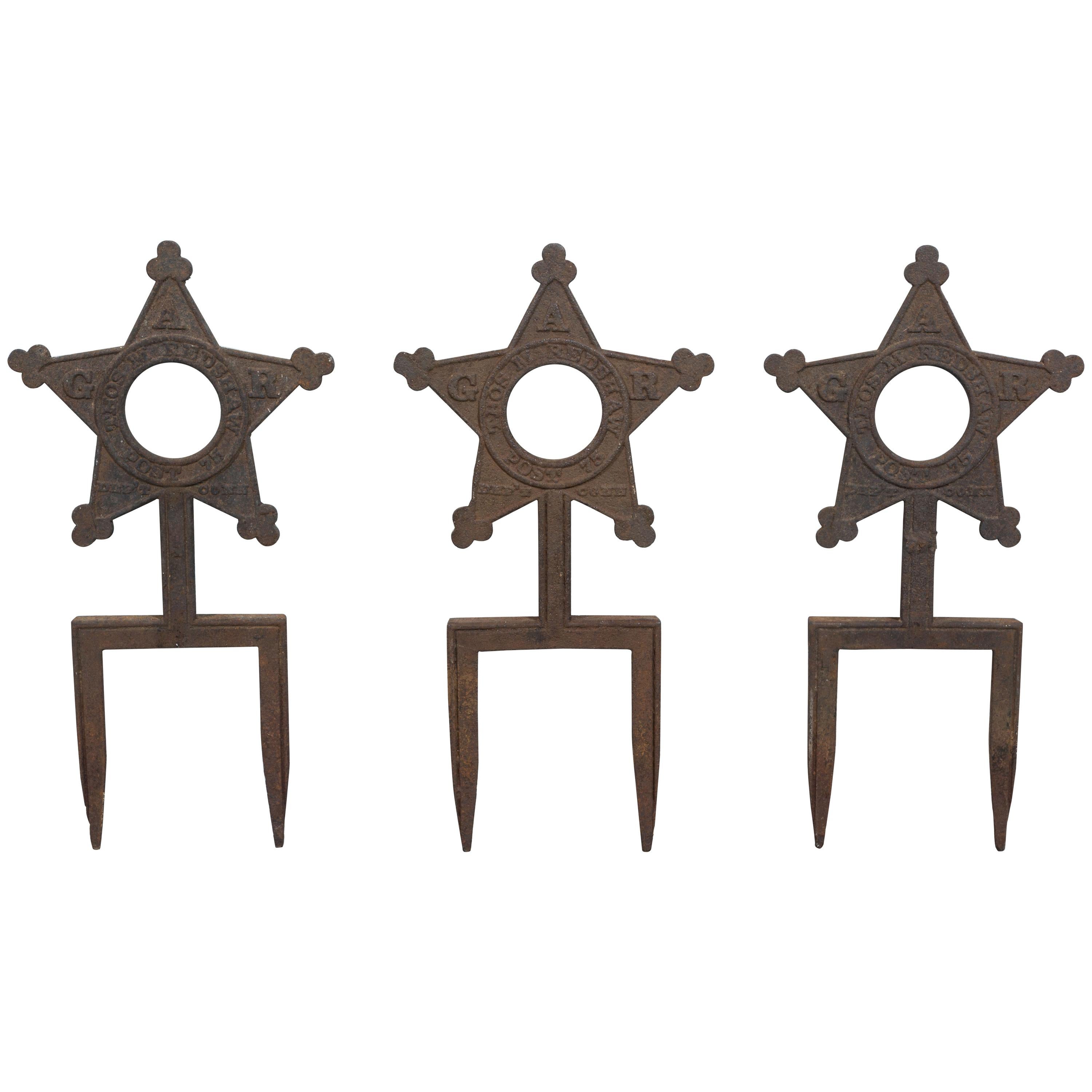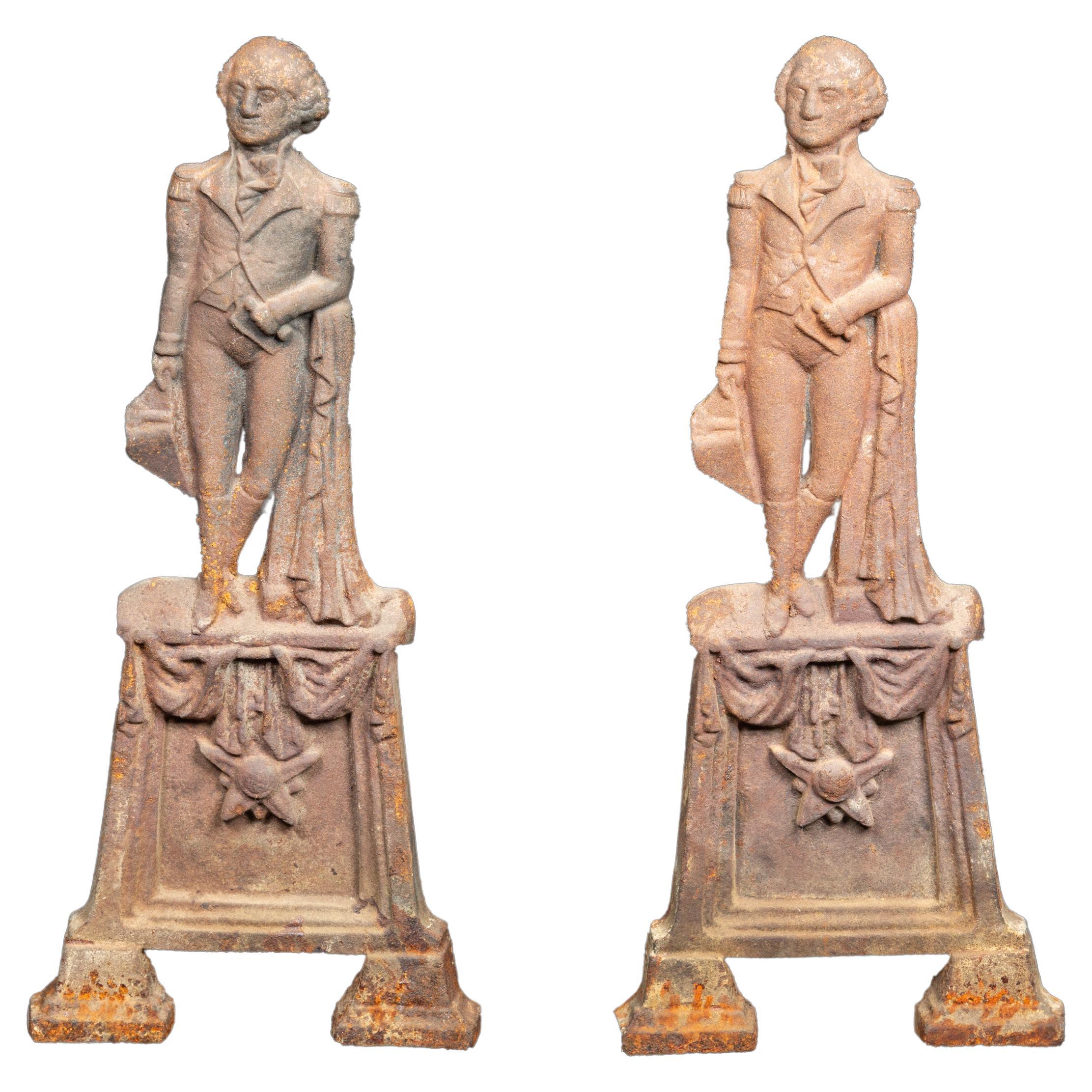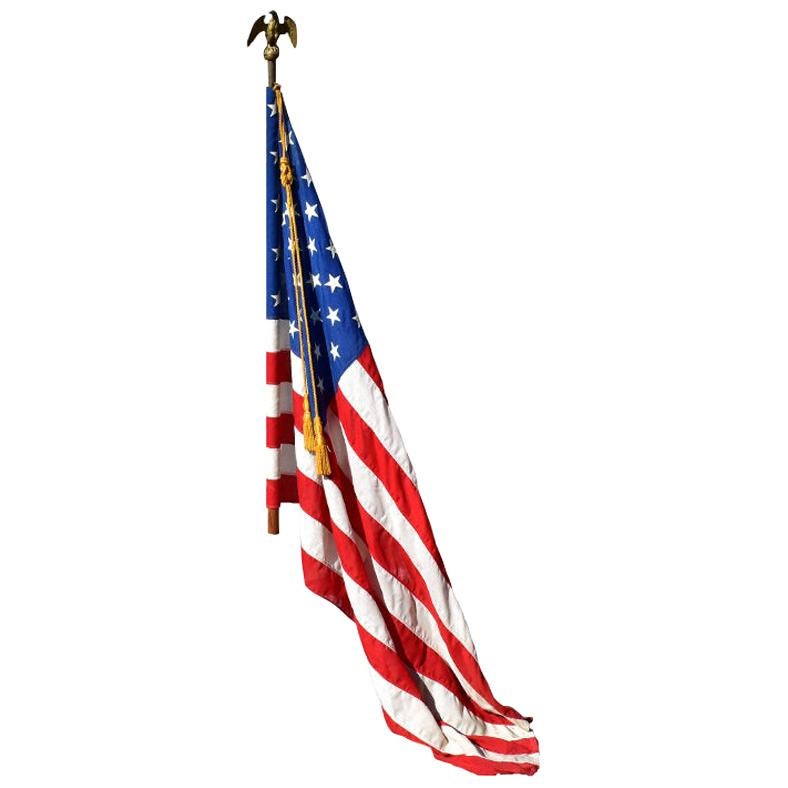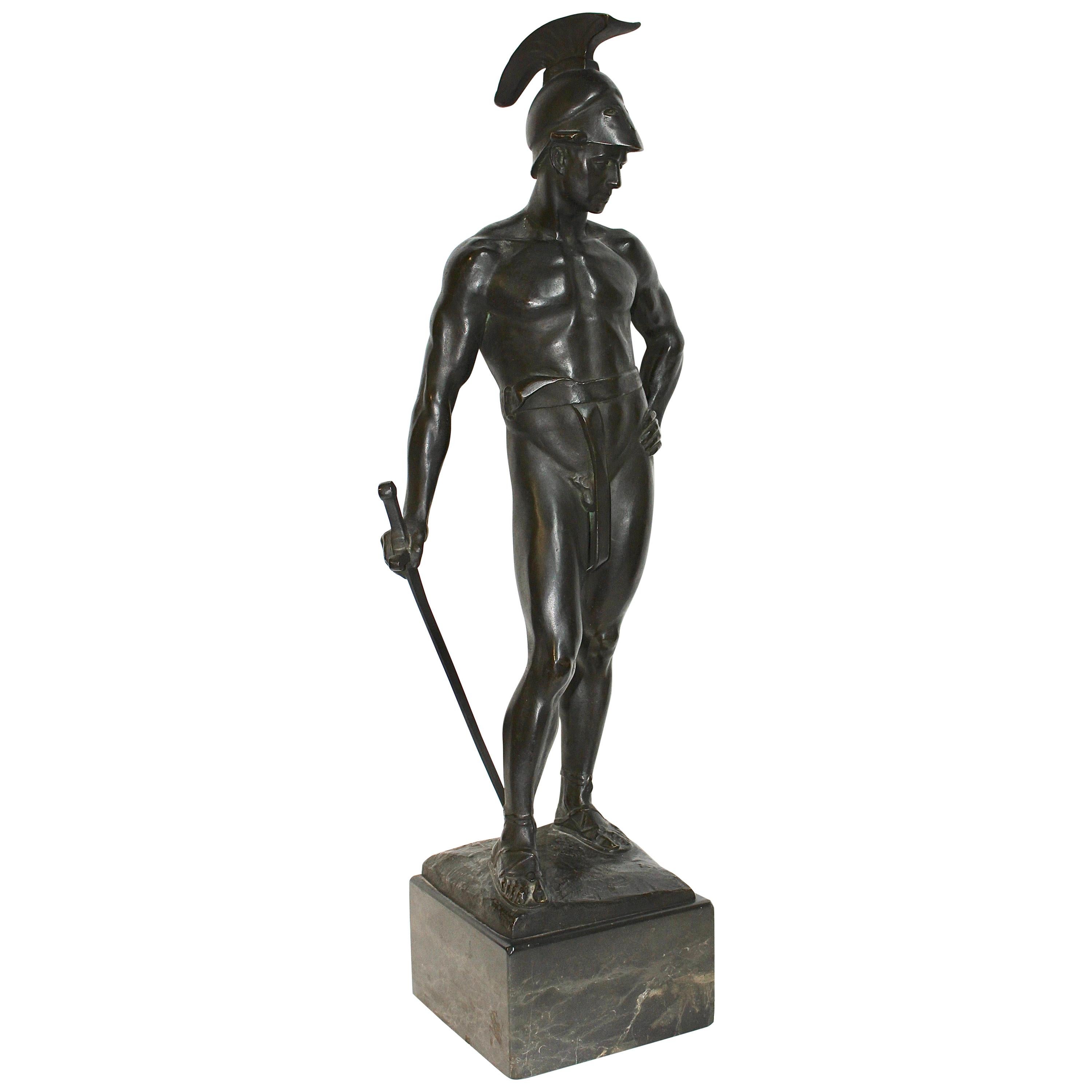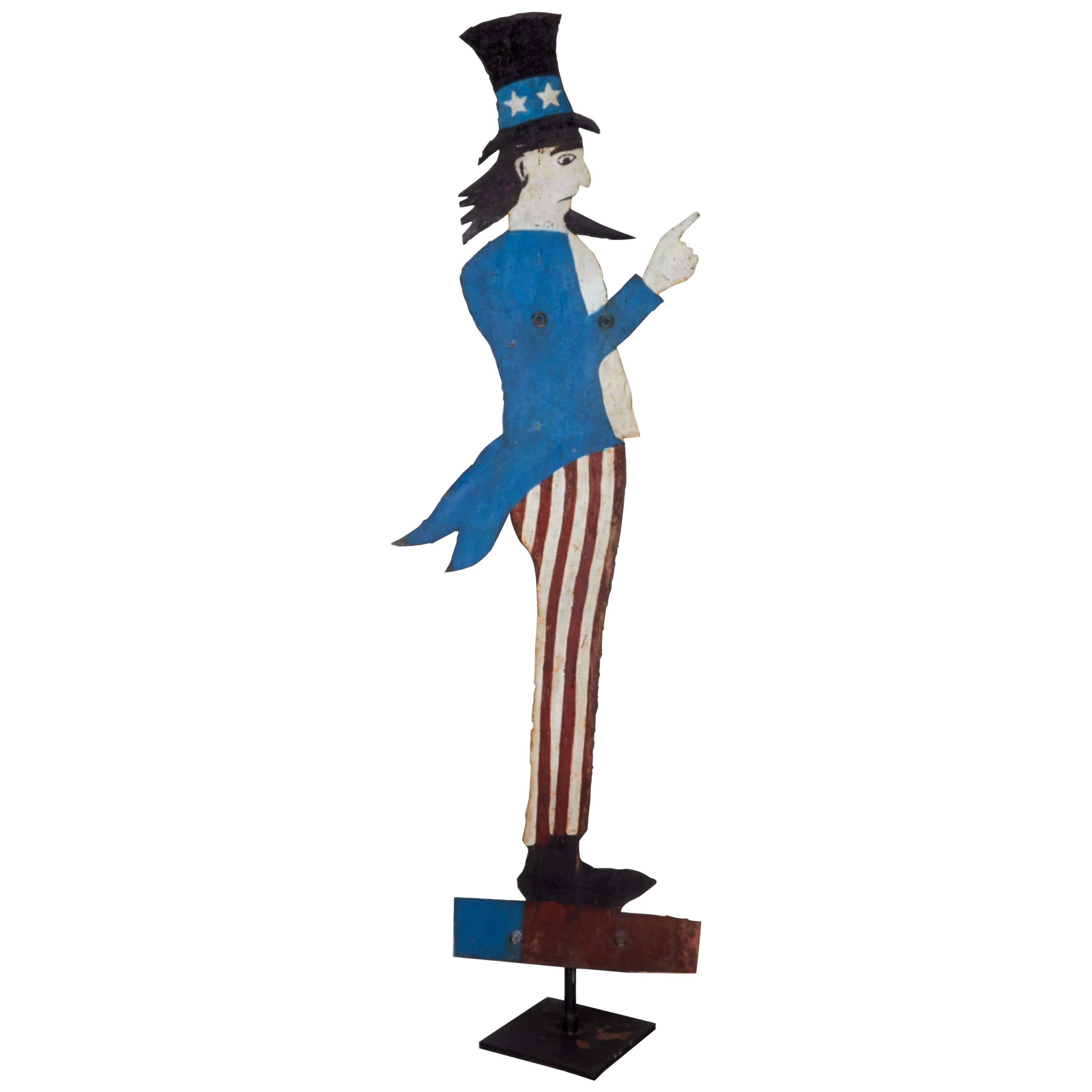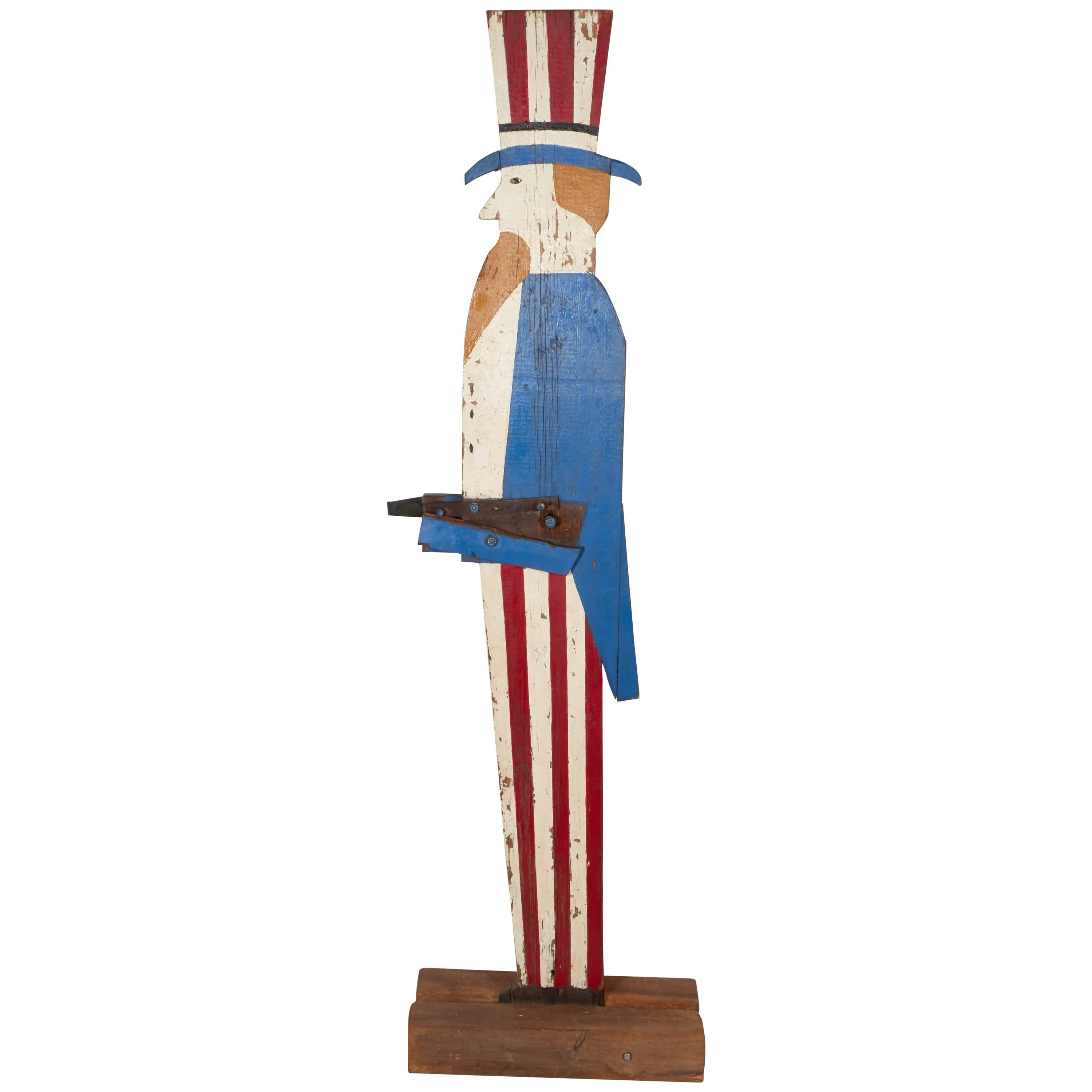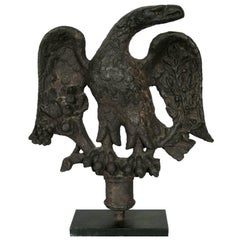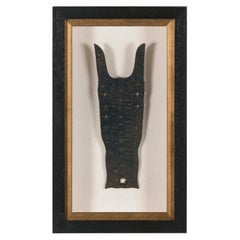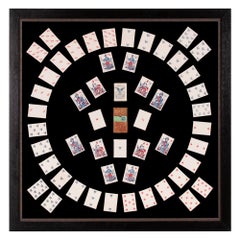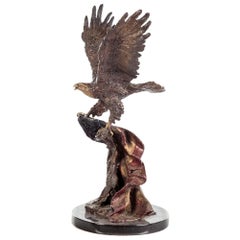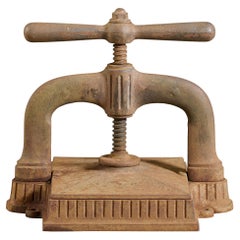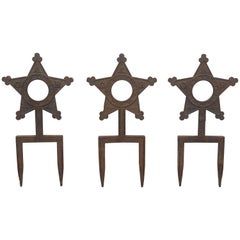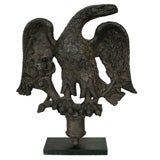
CAST IRON EAGLE, A BOOK PRESS COUNTERWEIGHT, MADE IN PHILADELPHI
View Similar Items
Want more images or videos?
Request additional images or videos from the seller
1 of 9
CAST IRON EAGLE, A BOOK PRESS COUNTERWEIGHT, MADE IN PHILADELPHI
About the Item
The Columbian Printing Press had a solid, cast iron, neoclassical eagle as a counter weight. It balanced on the lever, which was in the form of serpent. Designed by a man named George Clymer, the press was operating in Philadelphia as early as 1813. The counterweights came in three sizes, of which this is the smallest (16.5” x 14”). This one is extraordinary among surviving examples, however, with respect to both its condition and outstanding patina. Note the early, snake-head form and the uncommon level of detail.
- Dimensions:Height: 16.75 in (42.55 cm)Width: 12 in (30.48 cm)Depth: 3.5 in (8.89 cm)
- Materials and Techniques:
- Place of Origin:
- Period:
- Date of Manufacture:1813-1820
- Condition:
- Seller Location:York County, PA
- Reference Number:Seller: fcs-0871stDibs: U0902228497118
About the Seller
5.0
Recognized Seller
These prestigious sellers are industry leaders and represent the highest echelon for item quality and design.
Established in 1991
1stDibs seller since 2008
61 sales on 1stDibs
Typical response time: 10 hours
More From This SellerView All
- American Federal Period Cast Iron EagleLocated in York County, PAThis cast iron eagle is one of the earliest sculptural forms that one will encounter in the marketplace. It is also one of the most attractive and ico...Category
Antique 1810s American Political and Patriotic Memorabilia
MaterialsIron
- Cast Iron Boot Jack Made for 1864 Presidential Campaign of George McClellanLocated in York County, PACAST IRON BOOT JACK, MADE FOR THE 1864 PRESIDENTIAL CAMPAIGN OF GENERAL GEORGE B. MC CLELLAN, WITH A FANTASTIC SLOGAN THAT READS "THE UNION AT ALL HAZZARDS" Made for the 1864 presidential run of George B. McClellan, this cast iron bootjack is both rare and graphically exceptional. Displaying the original black-painted surface, with attractive and desirable patina, the stylized profile has a wonderful folk art quality. Molded block letters that wrap around the heel clasp read simply "Gen. Mc Clellan. These are accompanied by a prominent Civil War-associated slogan: "The Union at all Hazards." The text is intermingled with 34 stars, which was equivalent to the number of states during the opening two years of the war, but was one star short by mid-1863 and two stars short by the time of the actual election in 1864. It's not unusual to encounter this feature in civil war campaign parade flags as well as all manner of flag-related ephemera. The iron was reportedly cast by G. & D. Cross of Morrisville, New York, though it is unsigned and I have not yet verified the attribution. I have seen two other examples, one of which had a broken and repaired tine on the U-shaped horns and newly painted surface, while the other appeared to have broken lifters and inferior, rusted patina. This is, hands-down, the best of the identified examples. Brief History of the 1864 Campaign: President Abraham Lincoln had a checkered relationship with his 1864 opponent, who he had formerly chosen as General-in-Chief of the entire Union Army. The career officer repeatedly knocked heads with his Commander-in-Chief. Having raised a well-trained and organized military force, McClellan often seemed reluctant to use it. By 1862, after losses in Virginia during the Peninsula Campaign, Lincoln grew frustrated with McClellan and the progression of the war and removed him from command. By the early part of 1864 the American people shared some of the same frustrations and Lincoln was no longer the clear choice for the White House. The nation was tired of war and the remains of the Democratic Party...Category
Antique 1860s American Political and Patriotic Memorabilia
MaterialsIron
- 1862 Civil War Playing Cards with Stars, Flag, Sheilds and EaglesLocated in York County, PA1862 Civil War playing cards with stars, flags, shields, & eagles, and face cards illustrating civil war officers and lady, Columbia, ca 1862, Benjamin Hitchcock, New York 1862 Civil War playing cards with suits represented by stars, flags, shields, & eagles, in lieu of the traditional French suits of hearts, diamonds, clubs, and spades. The face cards feature Union Army officers and Lady Columbia [a.k.a. Lady Liberty, Goddess of Liberty]. Entitled “Union Playing Cards,” two versions of this deck were produced in New York by Benjamin W. Hitchcock’s “American Card Company.” This is the earlier of the two. The other was released in 1863. There are 52 cards in total with the ace of spades doubling as the title card, as was often the case during the 19th century. The telescoping box...Category
Antique 1860s American Political and Patriotic Memorabilia
MaterialsPaper
Price Upon Request - Civil War Apron, Made In Cambridge, OH by Laura, Hynes, ca 1861Located in York County, PACIVIL WAR PERIOD APRON, MADE IN CAMBRIDGE, OHIO IN 1861 BY 12-YEAR-OLD LAURA HAYNES, WORN BY HER AT BENEFITS FOR THE U.S. SANITARY COMMISSION, PREDECESSOR OF THE RED CROSS, THAT STAFFED, FUNDED, AND MODERNIZED CIVIL WAR HOSPITALS Laura Haynes was born on the 17th of June, 1847 to Vincent and Sarah (Dillon) Haynes of Westland, Ohio (southeast of Columbus and due south of Zanesville). Vincent was listed as a physician in the 1850 U.S. Census, then as a lawyer in 1860, apparently having pursued both fields. It stands to reason that that during the Civil War (1861-1865), the Haynes family, being of means and with Vincent involved in the medical profession, might become involved in philanthropy to benefit Civil War hospitals. Made of plain weave cotton, this patriotic apron features 18 white, appliquéd, hand-sewn stars on a blue ground, cinched at the waist, with a blue belt incorporated below, followed by 13 vertical stripes, alternating red and white, likewise cinched, so that top and bottom have opposing triangular profiles. Aprons of this period did not generally have a loop or tie that went about the neck, to keep the breast portion up, but were rather pinned in place. All of the construction was accomplished by hand-stitching. One can see in the more crude stitching of the stars, how much more difficult it was to perform appliqué work than it was to hem fabric, especially for a 12-year-old girl. While the count of 18 stars may have had no purpose other than to fill the available space, to create a patriotic display, it may just as likely have been selected to reflect the number of states that were felt to be loyal to the Union at the time. Until July 4th, 1861, there were officially 33 stars on the American national flag. This, less the entire complement of 15 Slave States, would arrive at a count of 18. President Abraham Lincoln urged the nation not to do this, desiring not to give credence to secession, with his goal of keeping the Union together. But there were no flag police and people did as they wished, creating versions of the Stars & Stripes in both the North and the South that removed those the respective maker(s) deemed loyal to the opposition. Although rare, a number of American flags of the Civil War era are known that display 18 stars, likely to reflect the removal of 15 Southern States. In the upper center of the striped portion of the apron is a fraternal ribbon, made of blue satin silk, with a white metal brooch at the top and a gold button with an eagle below. This is decorated with a printed 13 star flag ribbon (applied), and with gilded text that reads: “The Women and Girl Workers of the Civil War; ’61-’65.” Next to this is the membership badge of the Women’s Relief Corp, which served as the women’s auxiliary of the Grand Army of the Republic, the primary organization for Civil War veterans. Below these, a hand-lettered exhibition tag was adhered, that reads as follows: “Made in 1861 at Cambridge Ohio by Laura Haynes; Age 12 Years; and Worn at Benefits for the Sanitary Commission [The Red Cross of 1861-5],” Followed by “Laura H. Green; Hotel St Mark; Oakland Calf.” Along the bottom of the tag is a brief title: “Flag-Apron of 1861-5,” with a circled item number “27.” The Sanitary Commission was founded in the Spring of 1861 by private citizens in New York City, who were appalled by the Army’s lack of medical supplies and sanitary conditions in the care of Civil War soldiers. Officially sanctioned by the War Department on June 9th of that year, and approved by Abraham Lincoln on June 13th, the chief planner and organizer was Boston-born writer and Harvard-educated clergyman, Henry Whitney Bellows of New York (b. 1814, d. 1882). Bellows modeled the organization after the work of Florence Nightingale in the British Sanitary Commission of the 1850’s, and brought with him a force of volunteers belonging to an organization he led called the Woman’s Central Association of Relief of New York. In 1863, Bellows would become one of the four founders of the Union League Club of New York, with fellow Sanitary Commission leaders Frederick Law Olmsted (the designer of Central Park, considered to be the father of modern landscape architecture,) plus George Templeton Strong (American composer, painter, lawyer, and prolific diarist), and Oliver Wolcott Gibbs (Harvard professor, chemist, and physician). The goal of the Union League Club was to join like-minded and influential, moneyed men with the cause of both the Commission and the Union in general. In 1881, Sanitary Commission nurse Clara Barton would carry the torch forward, expanding upon the concept to form the Red Cross. Sanitary Fairs—large, fundraising events held to benefit the Commission—were held in New York, Philadelphia, Baltimore, Chicago, St. Louis, and elsewhere. The Northern Ohio Sanitary Fair was almost certainly attended by Laura Haynes, 16 years old by that time, who is likely to have worn the apron there. Held in Cleveland from Feb. 22nd – Mar. 10th, 1864, the fair was opened by Major General James Garfield, future President of the United States, who, it is said, was extremely well received. About 3 years later, on June 11th, 1868, Laura married Robert M. Green of Cambridge, Ohio (northeast of Westland), who shared her June 17th birthday. Born 2 years prior to Laura, in 1846, Robert enlisted as a Corporal with “A” company of the 85th Ohio Infantry, a 3-month unit, on May 27th, 1862. Mustering in on June 10th, I Columbus, at Camp Chase, the 85th was assigned to guard Confederate prisoners at the garrison. He mustered out on the 23rd of September. By 1880, Robert & Laura Green had relocated to Oroville, California (Butte County...Category
Antique 1860s American Political and Patriotic Memorabilia
MaterialsCotton
Price Upon Request - Pressed Brass Eagle, Parade Flag Holder and Bunting Tie Back, ca 1880-1895Located in York County, PAPressed brass eagle, an early parade flag holder & bunting tie-back, an especially attractive example, circa 1880-1895 Pressed brass eagles decorated the interiors of Civil War ve...Category
Antique Late 19th Century American Political and Patriotic Memorabilia
MaterialsBrass
- Franco-American Textile with the Image of an Eagle Holding the American and FlagLocated in York County, PAFranco-American textile with the image of an eagle supporting knotted and draped american and French flags beneath four war planes; embroidered silk floss and metallic bullion thread...Category
Mid-20th Century American Political and Patriotic Memorabilia
MaterialsSilk
You May Also Like
- Eagle and Flag Bronze Sculpture by Lorenzo E. Ghiglieri, Limited Edition 205/475Located in Colorado Springs, COPresented is a patinated bronze eagle by Lorenzo E. Ghiglieri. The eagle is depicted landing on a tree stump, with wings dramatically raised. The stump is draped with a polychrome American flag. The bronze is signed "Lorenzo Ghiglieri...Category
Late 20th Century American Animal Sculptures
MaterialsBronze
- Cast Iron Book PressLocated in Chicago, ILCategory
Vintage 1910s Italian Antiquities
MaterialsIron
- Collection of Three Cast Iron Star Victorian Daughters of the Revolution MarkersLocated in Santa Monica, CACollection of three Daughters of the Revolution cast iron star markers. Marked GAR Thos Feushaw Post 75 Conn.Category
Antique 1890s North American Folk Art Garden Ornaments
MaterialsIron
- Pair of Cast Iron George Washington Figural AndironsLocated in New York, NYPair of cast iron George Washington Andirons: Measures: 9" x 20" x 16" Weighs: 30 LBS.Category
Early 20th Century American American Classical Andirons
MaterialsIron
- French Women Bust Sculpture "Marianne" Godess of Liberty in Solid Wood, 1960sLocated in Antwerp, BEVintage French bust sculpture of a woman Marianne has been the national personification of the French Republic since the French Revolution, as a personification of liberty, equality, fraternity and reason, and a portrayal of the Goddess of Liberty...Category
Vintage 1960s French Mid-Century Modern Busts
MaterialsWood
$1,138 Sale Price64% Off - Very Rare West Riding Constabulary Cast Iron Wall PlaqueLocated in Chillerton, Isle of WightVery rare west riding constabulary cast iron wall plaque This branch of the British police force was established in 1825, Yorkshire was divided into ...Category
Antique 1890s British Colonial Political and Patriotic Memorabilia
MaterialsIron
Recently Viewed
View AllMore Ways To Browse
Cast Iron Press
Eagle Snake
Eagle And Snake
Antique Cast Iron Eagle
Iron Serpent
Antique Iron Book Press
Book Press Iron
Antique Counterweights
Antique Cast Iron Press
Folk Art Serpent
Cast Iron Snake
Cast Iron Book Press
Antique Book Press Cast Iron
Antique Cast Iron Book Press
Cast Iron Eagles
Cast Iron Eagle Head
Used Drapes
Head Stand
